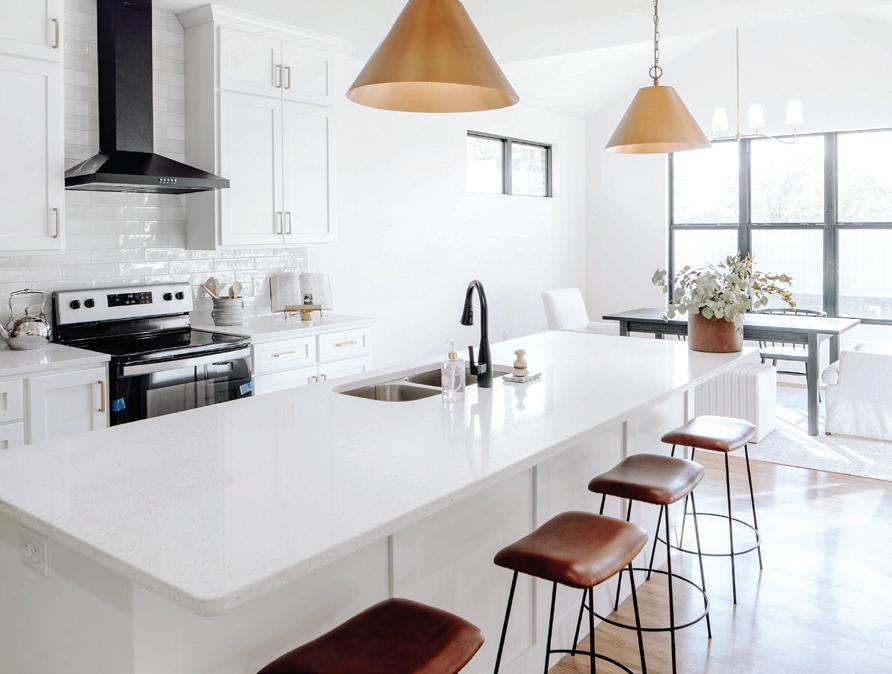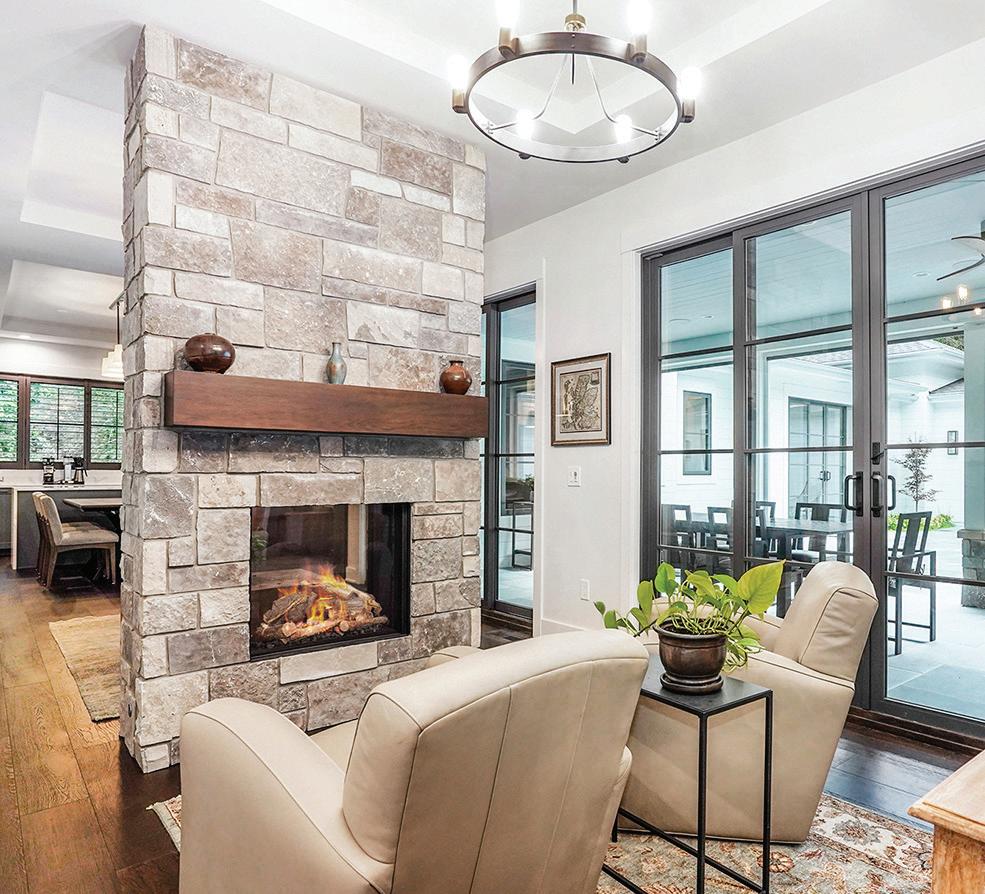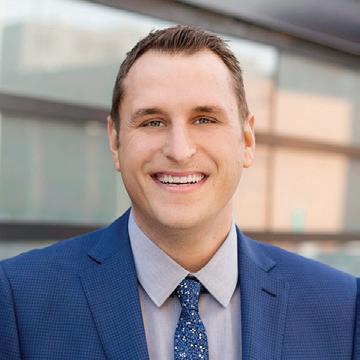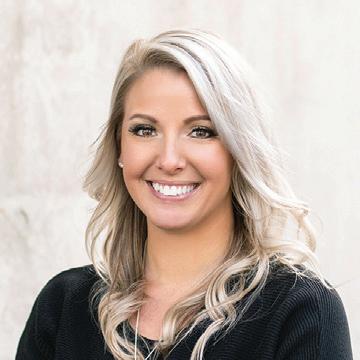A Deep Dive into the West Michigan Market
EVERYTHING YOU NEED TO KNOW TO NAVIGATE THE REAL ESTATE MARKET IN THE COMING YEAR


EVERYTHING YOU NEED TO KNOW TO NAVIGATE THE REAL ESTATE MARKET IN THE COMING YEAR

The truth these days is hard to find in a culture that thrives on clickbait and fear. This edition of Insight is a non-biased, micro dive into this extraordinary place we call home— West Michigan. Everyone we’ve featured in this edition are leaders within their industries, have a reputation of being creditable, and lastly, they are all fellow West Michigan residents.
Our mission as a company has always been to inform and educate our clients, above all else. This publication in particular, is born out of our passion to share with our community the information we see from the front lines, and in turn to make them savvy consumers.
As the second largest residential mortgage company in Kent and Ottawa counties, based in downtown Grand Rapids, we have an incredibly unique vantage point of the ever-changing economy and real estate market in West Michigan. We see firsthand, in real time, buying trends based on economic expansion and job growth, supply and demand, government incentives and legislation, and more importantly, who is buying and the types of properties they desire.

Kevin Polakovich & Brendan O’Driscoll
The State of the State’s Real Estate Market
Walter Perschbacher
Building Our Way Out of a Housing Shortage

Mike McGiveny
Building Dreams
Ryan Yearack
West Michigan: The Hidden Gem of the Midwest

Katie Karczewski
Can Appraisers Predict the Market?
Blaine Feyen
The New Normal
Michael Berkemeier & Aaron Veldheer

Getting the Right Guidance Makes All the Difference
Scot Veneklase


Currently, the local housing market has more inventory than we’ve seen in a few years along with a lower amount of prospective buyers. This leads to a more stable home buying experience without all the ultra aggressive offers. The competition in the market today is less frantic than in the past couple years, allowing buyers more time to make a decision and do their due diligence when purchasing a home. We are also seeing more FHA, VA, and MSDHA offers winning, seller concessions, and full inspections.
The media focuses a lot on potential bubbles, recession, market crashes, and fluctuating interest rates. While the truth of the matter is that the overall housing inventory is still low, and there are millions more buyers than there are homes for sale, creating a larger demand. With high demand for houses, there is no reason to think that a crash in the residential market is coming. This is bolstered by

strong lending guidelines and strict appraisal requirements. The builders are not building enough homes to keep up with the housing need, and they are not likely to catch up to the inventory shortage for years.
This continual lower supply keeps demand high, and therefore stabilizes increasing home prices. So what should you do? Continue renting, or dive into the housing market? Paying rent still isn’t the best option. Last year rental prices went up 13%, and are predicted to go up at least another 5% this year. Not to mention that paying rent goes 100% into someone else’s pocket.
When it comes to buying a home, you have to take into account both home price appreciation and interest rates. The home you buy today will most likely cost 8-10% more 12 months from now. Imagine paying $40,000 more for a $400,000 house next year or $15,000 to $20,000 more for
Currently, the local housing market has more inventory than we’ve seen in a few years along with a lower amount of prospective buyers.
a $200,000 house next year. Interest rates have gone up this year, but interest rates are temporary. They cycle up and they cycle down.
Based on these patterns, purchasing a home today allows you to buy a home at a lower purchase price and start building equity—with the opportunity in the near future to refinance to a lower rate.
West Michigan is a particularly strong market; affordability is better here, income is better here, and the cost of living is not extreme like so many parts of the country. If you need to buy a house to get into a different school district, make room for a growing family, relocate for a new job, adjust to a life change, or just for a change of scenery—we recommend diving into the market so you can start building wealth. Give us a call today so we can chat about your unique situation, and help get you into your new home!

 Walter Perschbacher President-Elect of Greater Regional Alliance of Realtors
Walter Perschbacher President-Elect of Greater Regional Alliance of Realtors
It seems like everybody’s talking about the housing marketing right now. Is this a bubble? Should we be worried? Is it a good time to sell? What’s happening with interest rates? There are a lot of questions. We sat down with the President-Elect of the Greater Regional Alliance of Realtors (GRAR), Walter Perschbacher, to get a little clarity on the current situation.
If there’s one thing we know for sure, it’s that the West Michigan real estate market is hot with a capital “H.” In recent years, home prices have accelerated the fastest they ever have (like, ever). Unfortunately, this is affecting firsttime homebuyers the most, because homes priced at $150,000 to $300,000 command the highest levels of competition.

1. Location, location, location. Over the past decade, there has been a culture shift in our region, especially within Grand Rapids and surrounding areas. Grand Rapids is now filled with amazing dining options, arts and culture opportunities like ballet and opera, sporting events, big-name concerts, and great shopping. We offer small-town living with big-city amenities.
2. People have equity in their homes, which wasn’t the case during the housing crisis of 2008.
3. The stock market has become less volatile, so real estate is a safer investment.
4. Companies like Open Door and Zillow were selling to out-of-town investors and flippers.
5. There’s high demand and nationally, we are experiencing a housing shortage. Simply put, there are too many people, not enough homes.
6. Restrictive zoning laws will not allow new builds in certain areas of the city.
But this is not a housing bubble. “I hear 2022 being compared to the housing crisis of 2008 a lot,” Perschbacher says, “and that’s just not right.” While the 2008 recession was caused by real estate, our current market is fluctuating so much because of factors we haven’t experienced before in our lifetimes: a global pandemic, war, rising interest rates, and a national housing shortage.
Over the past ten years, the role of the real estate agent has changed drastically. “As a Realtor, you have to be super knowledgeable and really on top of things,” Perschbaucher says. “We’re no longer just competing with other local agents, but homeowners who are attempting to buy and sell online through sites like Zillow.”
The data shows that time-and-time again, the best way to get a good deal and sell a house is to list on the MLS—something only a Realtor can do for you. Plus, in our ever-changing market, a Realtor is going to be way more plugged in.
So, why use a real Realtor?
1. Purchasing a home is about more than just price. You need to know what to look for, how to coordinate with all the other parties involved, and be available at the drop of a hat.
2. The stakes are high. Many people’s homes are their #1 investment in the portfolio.
3. Often, the need to move is brought on by a major life change, like the birth of child, marriage, death, or divorce. It’s a highly emotional transaction, and you need someone to advocate for you rationally.
4. In a hot market like ours, a Realtor’s relationship with the Realtor on the other side of deal can sometimes make or break a buyer’s deal being accepted.
5. Markets are ever-changing. It’s a Realtor’s job to understand the ups and downs and help you navigate these changes.
The most common question in real estate right now is, ‘Should I wait to buy or sell?’ Although the market may seem totally unpredictable, Perschbacher says that’s pretty normal. “No one can really predict what the market is going to do because we have never come across this unique set of challenges before.”
One of the issues right now when it comes to inventory is that the two largest generations are at odds with each other, Millennials and Baby Boomers. Boomers are healthier, living longer, and have built wealth. They’re not ready to trade their suburban home for a condo because most of them are still fine maintaining it. Millennials want to buy, but there’s just nothing to buy right now—because the Boomers are still in their homes.
Another issue is that home building has slowed down considerably in the past twenty years. Many development companies are building rental units because they are often more profitable. When it comes to building more homes, modern zoning laws have created some challenges, and many new developments are not a moderate or market price point.
The market is never truly balanced, so it’s a good idea to just hop on your surfboard and ride the wave.

Blaine Feyen has been in the appraisal business since the ‘90s. “Long enough to see three distinct shifts in the market,” he notes. And he knows that appraisers aren’t well-liked because, to be frank, they can sink the whole deal.
Covid changed how appraisers work—but not all for the worse. Like many other areas, there’s a shortage of workers… which is likely why your home is being held up with the appraisal process.
So, we’re going to explain what an appraiser is, what they do, why there’s a shortage, and why even they can’t predict the market.

BLAINE FEYEN
Owner & Founder of Real Value Group
“West Michigan is in its own little bubble… it’s hard to predict.”
An appraiser’s job is to determine the current value of a property for the potential buyer. Most of the work to determine the value of a real estate appraisal is done during an on-site inspection, where the appraiser will:
• Conduct a room-by-room walk-through to appraise the condition of the interior.
• Walk the length of the property for an appraisal of the condition of the exterior.
• Appraise the value of any amenities, like a finished basement, swimming pool, or built-in bar.
• Note any health or safety code violations.
• Record the layout of the property, inspect the square footage, and determine whether it’s a single family dwelling.
Off site, the appraiser may also evaluate the current real estate market, considering comparable properties in the neighborhood, to help evaluate the home’s value or fair market value of the property.
The appraiser will then draw up a report to let the lender and the potential home buyer know if this is a worthwhile investment.
Homeowners also sent photos and videos of the inside of the house as well as having a phone call with their appraiser, so that they could adequately inspect the interior, too.
Blaine said that before Covid, he and his team would spend endless hours on the road driving from home to home across the state. This new method of appraising has proven to be effective and is a total time saver.
But on the flip side, appraisers were in high demand during the Covid housing boom. So, there was a shortage, making the process even more drawn out. Some states were backed up for three or more months. This happened in North Dakota, and they actually had to declare a state of emergency. Blaine thinks this is why there were so many appraisal waivers during Covid—to speed up the process and ensure that the home purchase would go through.
A big delay in the system was coming from the humans themselves. Blaine said that during the life cycle of an appraisal spends about 85% of it’s time sitting in queue, waiting for someone to work on it.
During Covid, it was unsafe to go and poke around in people’s homes. Instead, appraisers started conducting “drive-by appraisals,” where appraisers drive past the home and inspect the outside rather than going in.
Technology has gotten so good that they can risk model much better today because of all the data that’s been gathered from houses across the country. 30 years ago, we didn’t have access to these data points. But technology can’t tell if someone has 27 cats, the house smells gross, or if there’s a crack in the foundation. So, real human appraisers are still needed.

In short, they don’t. Blaine explains, “West Michigan is in its own little bubble… it’s hard to predict. Plus, ‘market’ is a big word. Markets are local. We’re insulated in West Michigan—not like Boise, Austin, Tucson, or other boomtowns. And we need to remember, West Michigan is still very cheap compared to New York or LA.”
What Blaine is saying is that it’s all relative. Wages are good in West Michigan, there’s an influx of wealth to prop up the markets, and we also have great free education. So, we’re kind of an anomaly.
“With that being said, humans are pattern seekers. But if you’re looking at the last market change in 2008-2009, that was caused by something completely different than what’s happening now. We have lots of factors that many of us have never experienced before in our lifetimes, like a pandemic, supply chain issues, a labor shortage, a potential recession, and war,” Blaine explains.
So, not even the appraisers know what’s going to happen with inventory. Blaine said when he saw his first price decrease come across his desk “It was called a ‘massive price improvement,’” he jokes.
If you want to know how the economy’s doing, ask an economist, right? No offense against economists, but it seems more practical to ask people who are doing more than predicting. People like Michael Berkemeier and Aaron Veldheer of Strategies Wealth Advisors in Grand Rapids, who are helping their clients spend and invest their money wisely.

 Aaron Veldheer & Michael Berkemeier Managing Director & Founder Strategies Wealth Advisors
Aaron Veldheer & Michael Berkemeier Managing Director & Founder Strategies Wealth Advisors
Michael, Founder, and Aaron, Managing Director at Strategies Wealth Advisors, are two good friends who started a wealth advisory company to help people build their legacies. Michael and Aaron are building a legacy right alongside their clients. They are committed to bettering the lives of their employees and are growing at a crazy rate because of it. They are true believers in “you can talk about it, but you gotta be about it.” They’re so devoted to this, in fact, that they sent each of their employees on a vacation of their choosing to show just how appreciative they are.
They practice what they preach, and don’t advise something they wouldn’t tell their own family. So, we asked Michael and Aaron to give us the inside scoop on what their clients are investing in right now, their take on the real estate market, and an economic viewpoint of what’s happening in West Michigan and the nation.

“The biggest thing to know,” Michael says, “is that people are fear-based right now. How can we combat those worries? With good, solid information.” With inflated news stories and lots of biased predictions, it’s hard to tell what’s true and what’s clickbait.
But Michael and Aaron are both so confident in the market here in West Michigan, that they have personally invested in it. “We put our money where our mouth is,” says Aaron.
“It’s just a matter of when,” Aaron says. “A house is a home, not just another investment. It’s the place where you’ll open Christmas presents, bring home
Take a deep breath.
It’s all going to be okay.
your new baby, see your kids grow up… You can’t shoot hoops out back with your Apple stock,” he jokes.
“Some of our clients are worried about investing in real estate because it doesn’t pay you an income,” Michael adds. “But we like to take a holistic view of the balance sheet and make sure portfolios are diversified.”
Right now, the stock market is unpredictable while real estate is holding steady. With a diverse range of investments, it makes even risky financial moves feel safer.
“West Michigan is a safe place to invest in the real estate market. People are coming here in droves from big cities,” says Michael. This Is The New Normal
“The market isn’t a bubble that’s going to burst. We’re not going to hit a cliff like we did in 2008 because this market change isn’t built on shady business practices,” says Aaron. “I don’t believe we’re going to see foreclosures, houses selling for $10,000, or other crazy things like that. This is just the market normalizing.”
When we look at the facts, this makes a lot of sense.
• Interest rates were at record lows during 2020-2021.
• There’s a national housing shortage. (Econ 101: supply and demand.)
• Inflation is up, but so are wages.
• Employment numbers are high.
• Companies are hiring, which means they are doing well.
• Appreciation is healthy.
“Another thing to remember is that banks are stable. Houses are going for fair prices. And this inflation that just happened in the residential world was long overdue because supply was so down,” Michael notes.
If you keep saying to yourself, “I’ll just buy when the market cools down,” Michael and Aaron are not convinced that’s going to happen. They predict that interest rates and equity are going to continue to rise to hopefully level the market out.
“When we think back to rates in the ‘80s, interest was at like 18 or 20%. Comparing that to today’s low rates, we need to look at how the market can find its middle ground again,” says Aaron.
“There may be a recession, and it could impact a lot of things,” Michael says. “I just don’t think it’s going to have a lot of impact on housing.”
“It really depends on the length and depth of the recession. But I think we’ll get through smoothly on housing because this is not like 2008 when the recession was caused by an issue with mortgages.”
So, what’s the lesson here? We think it’s ‘don’t believe everything you hear.’ Check the facts. Come to conclusions yourself. Talk to an expert, like Michael or Aaron, who can advise you on how to financially weather any storm.
Take a deep breath. It’s all going to be okay.

Scot Veneklase has been in the mortgage industry for just over 21 years. He’s seen it all: the ups, the downs, and everything in-between. With the onset of rising rates, he’s here to offer some smart advice from an industry veteran.
Scot doesn’t take his job lightly. “Your home is a big deal. And I feel honored to be part of that decision.”
As a family man himself, married to his high school sweetheart with two kids, Scot understands that for most people, moving is not about whether the rate is up or down—it’s a life decision.
Don’t focus on interest rates too much. “The market flexes. It’s just how it is and always will be… My best advice? Purchase
a home based on your lifestyle and family needs, and not on what the market is doing. The interest rates are just part of the environment you’re in.

You can always refinance, but you can’t easily, or affordably, change your home.”
“My second piece of advice is to always work with an experienced local lender.” When you work with a lender who is both experienced and local, you automatically have an advantage. First, they have a keen
knowledge of the West Michigan market and the real estate agents who work in it. It’s this familiarity that allows them to go to bat for you by leveraging their proven reputation. Second, and this is key, an experienced lender will be able to structure a loan to meet your unique needs and situation. Most people don’t realize that getting the right guidance on a loan can make and save them a lot of money.
“For most people, moving is not about whether the rate is up or down–it’s a life decision.”
That being said, how do you find a good lender that can work with your specific needs? Scot put together a little checklist of five important questions to make sure they’re a good fit for you and your family.

1. Ask them and your agent about their reputation within the community.
2. How long have they been in the business?
3. What’s the flow of their pre-approval process?
4. Do they close on time?
5. Do they work with local appraisers?
So, what does the future of the West Michigan market look like according to a guy who’s seen it all? Scot is estimating that through the end of 2022 we will see double digit appreciation values with healthy appreciation into 2023. “Home values will not go down in West Michigan. I just can’t see that happening,” Scot says. “Houses are cheaper than they are going to be ten years from now. So, if you’re
waiting until things cool off, sorry, but that’s probably not going to happen.”
Unlike the 2008 housing crash, caused by bad lending practices, this shift will not impact the housing market. “I don’t see foreclosures happening,” Scot says. “Home values will continue to rise, and things will level out eventually.”
“Purchase a home based on your lifestyle and family needs and not on what the market is doing.”VP


True or false? Buying an existing home is more affordable than building a new one.
If you answered true, well, that used to be the case. But with a wide variety of options for custom and semi-custom building, a national housing shortage, and home prices up more than 20% from 2021, building has actually become a more economical option for many home buyers.
According to Mike McGiveny, VP of Sales at Allen Edwin Homes, it’s the builders who are the only ones who can “get us out of this housing shortage mess.” So, he and his team at Allen Edwin Homes have transitioned into building new homes with affordability in mind, especially for the underserved first-time home buyer market. With 75% of their clientele as first-time home buyers, 1,800-2,000 square-foot homes in the $200K-300K range are the sweet spot.
Well, what about the construction loan and building costs? With a semi-custom home builder like Allen Edwin, those things are covered. All they need is a mortgage. A buyer can get a pre-approved, put down earnest money, and lock in their rate—which is super important in our current climate.
Then why does home building have this stigma of being only for the super wealthy? Custom home builds can be pricey. But with semi-custom builds, the buyer still gets to pick from a wide range of options, like paint colors, cabinetry, finishes, flooring, and even things like a loft-style bedroom or finished basement —but it’s more controlled. Plus, with supply chain issues, semi-custom builders have more predictability since they use similar items again and again.
Even though Allen Edwin is building 700 houses a year (that’s about 2 a day if you’re not a math guy), they work hard to ensure they’re not overworking their construction crews. They know labor is at a premium right now, so they’re combating that by treating their crews right and ensuring them reliable, steady work.
Okay, so, you’re probably saying to yourself, “Even if it’s not as expensive as I thought, I’m going to have to wait forever to be able to move into the area I want.” Sorry, but wrong again. Allen Edwin focuses on building homes in popular West Michigan suburbs, like Byron Center, Caledonia, Hudsonville, Kentwood, and Lowell. See a house you love in Lowell, but really want to be closer to Kentwood? No problem. Lots of these semi-custom homes are being built, but then waiting to be finished until the right buyer comes along.
Another huge benefit to building with guys who have done the same thing multiple times before is that they can make it ultra-efficient. And we’re not just talking about the speed of the work. But also, the efficiency of the energy usage in the home. An Allen Edwin home saves approximately 30-40% on their energy bills, compared to a typical home built to code—which can add up to $300-350 a month in savings. They use all LED lighting that provides lower electrical costs and longer, more sustainable lighting. And when they’re working on a site? Well, they only use one dumpster for every three houses vs. the typical three dumpsters per one house.
So, this semi-custom home building thing? It really can save you money. And if you’re a first-time homebuyer who’s lost all hope of owning your own little slice of the American dream, maybe it’s not so far off after all.

“THE BUILDERS ARE THE ONLY ONES WHO CAN GET US OUT OF THIS HOUSING SHORTAGE MESS”
 Ryan Yearack
Ryan Yearack
The United States is experiencing a housing shortage. An article published by NPR in March of 2022 states that, “The U.S. is more than 3 million homes short of demand from would-be homebuyers.” That’s a lot of houses.
The solution to a housing shortage? Build new homes. But as we know in our new post-Covid world, things aren’t that simple anymore.
Once you’re able to find (and afford) land to build on, you’ll be met with a variety of ever-changing issues, including everything from the price of lumber to supply chain delays to worker shortages.
So, how can you, a potential future home builder, make sure that your project is going to go smoothly? Well, we sat down with Ryan Yearack, Owner-Builder of Custom RMY Construction, to chat about the new era of home building. As a custom home builder of 20+ years, Yearack has great insight into what it takes to make sure your build gets done right— despite the challenges.

As with anyone you hire for any job, it’s important to thoroughly interview them. Yearack provided seven important questions to ask your custom home builder to make sure you don’t run into any major delays or challenges once you’ve broken ground.
This question is kind of a “duh,” but it’s an important one, nevertheless. With the ever-changing landscape of home building, Yearack recommends that you use a custom home builder who has years of experience under their belt. “It’s a great idea to see a portfolio or samples of their work, too,” Yearack says.
Why is experience important? For starters, a seasoned builder will have a wealth of knowledge to draw from, including valuable connections that can possibly help them overcome labor shortages and even some supply chain issues. According to Ryan, “An experienced builder is not going to be bothered by problems. They’ve seen it all. They know what they’re doing. And they know how to work through any unexpected problem that might arise.” And if watching HGTV has taught us anything, it’s that there is always going to be some type of unexpected issue that comes up. (The drama!)
In the custom home building industry, it’s common practice to have the Owner-Builder run the project but not actually show up to the work site, or as you know it: your future home. But what if something goes wrong? Or a subcontractor isn’t meeting the Owner-Builder’s standards? If your Owner-Builder isn’t at the site, they would never know. And there could be a mistake made before it’s too late.
It’s the hottest word of the year: inflation. Pricing is unpredictable. Although the price of lumber has dropped dramatically since it skyrocketed in 2021, other things are now becoming more expensive. Ryan explains, “A typical industry standard for a builder’s markup to the customer is about 15%. This hasn’t changed since 2020.”
“But in this current climate, I’m going to be honest: people who are doing full custom builds need to have deep pockets. I’ve seen material costs skyrocket to $40,000 more than what we planned for at the beginning of the project. And, unfortunately, that’s not something a builder can predict, no matter how experienced they are.”
This question addresses the labor shortage headon. AKA, will there be people to put in the plumbing and electrical? Yearack says to “seek out home builders who have long-standing relationships with their subcontractors. These companies will likely not be as affected by the labor shortages.”
“Right now, it’s so important for me to keep my guys happy and busy. If I’m always giving my contractors a reliable schedule with new projects, they won’t need to go anywhere else for work. It’s as simple as that, really.”
Whether it’s rising costs, the six-week shutdown, labor shortages, or something else entirely, it’s good to know what you’re up against. As inflation rates continue rise, it’s ultra-important to understand how your builder handles price increases and unexpected roadblocks.
Yearack says, “There was never a time requests slowed down for me during Covid. People are still wanting to build houses. In fact, I’ve had to turn down work.
“It’s really the prices and the shortage of materials that’s messed with my work. When stuff doesn’t show up, it screws up everyone’s schedule.”
How often does the Owner-Builder show up to the work site?
3Do you have strong, long-lasting relationships with your subcontractors?
“An experienced builder is not going to be bothered by problems. They’ve seen it all. They know what they’re doing.”
How does Yearack handle that? “Lead time is now determining building timelines… And I hate to say it, but custom home building is a very tough industry to be in right now.”

No matter how on top of it your builder is, just be prepared for some delays. And remember that they are trying everything they can to make things move quickly for you.
“A lot of times, it’s not the builder that’s the issue. It’s ordering things like lumber, windows, or appliances,” Ryan says. With the microchip shortage, appliances are taking much longer to get to the customer. “Depending on the brand, you can wait anywhere from six months to a year-and-a-half for a fridge to come. Needless to say, that really messes with the build schedule.” Building basics are a huge issue, too. “There’s no alternative to wood… If we don’t have lumber, we can’t build.”
“Things are slowly getting better,” Ryan says, “but, right now, timing and cost are still unpredictable.”
Yearack’s secret to his success? “I truly care,” he says. “It’s good to make money, but I want people to like me after the project’s done.”
“We have a warranty on all our builds for a year. If something breaks, we’ll come and fix it—no questions asked. But I consider myself on the hook with my clients forever, even after the warranty expires.” It’s that kind of pride of workmanship and dedication that’s going to get you the best build possible.
Send him an email at ryan@rmycustom.com
7you
Interested in working with Ryan on a project?
“If something breaks, we’ll come fix it—no questions asked... I consider myself on the hook with my clients forever.”
 KATIE KARCZEWSKI Owner and President of Katie K Realty Team
KATIE KARCZEWSKI Owner and President of Katie K Realty Team
What’s
Well, if you ask long-time West Michigan Realtor, Katie K, just about everything.
We sat down with Katie Karczewski, Owner and President of Katie K Realty Team, to chat about why she’s still investing in the West Michigan real estate market after 35 years, and why she thinks you should be too.

When she was just starting out in the real estate business in the late ‘80s, Katie recalls heading into downtown Grand Rapids on a Tuesday night for a cocktail with a friend. “You could have shot a cannon off in the street, and no one would have heard it,” she jokes. “Things have changed a lot since then.”
“We have everything you could want from a big city, but it’s just a lot easier—less traffic, less hassle, and less cost. It’s like Chicago, but on a smaller, more manageable scale.”
So, what is it that put the “Grand” in Grand Rapids?
so great about West Michigan?
“We have everything you could want from a big city, but it’s just a lot easier—less traffic, less hassle, and less cost.”
Grand Rapids has made a huge effort to bolster the art scene. Of course, there’s the obvious: ArtPrize, an independent international art competition that has fills the city with art (and art lovers) every year. Downtown cafés, museums, and even churches hold expositions of art in all mediums made by artists from around the globe, and viewers can vote for their favorite piece.
There are amazing restaurants and bars throughout the city, with every kind of cuisine imaginable. The stream of new restaurants and bars seems constant, with delicious new choices popping up almost weekly. And the Fulton Street Farmer’s Market, a hot spot for Saturday morning shopping in the summer, if you’re more of the home-cook type.
Grand Rapids is home to the first LEED-certified art museum, the GRAM, which brings in brilliant traveling shows and has a gasp-worthy collection of its own. The Grand Rapids Public Museum is ramping

up for revitalization with plans for a $64 million expansion. We can’t forget about John Ball Zoo, Frederik Meijer Gardens & Sculpture Park, and a massive number of local parks, playgrounds, and other amazing places to discover.
If you’re in the mood for a show, there are so many options to choose from. Katie is a huge fan and a Board member of Broadway GR, which brings in eight Broadway shows annually to the DeVos Performance Hall. Right down the street, Van Andel Arena brings in international acts. And then there’s GLC Live at 20 Monroe, a smaller concert venue that hosts indie artists, mid-size acts, and dance parties. There’s also the Civic Theatre, Opera Grand Rapids, Grand Rapids Ballet, Grand Rapids Symphony, comedy clubs, state-of-the-art and historic movie theatres, concert venues, and clubs. Whew!
“So, if you’re bored in Grand Rapids, it’s your own fault,” Katie laughs.
With droughts out west and flooding down south, climate change is becoming a factor in choosing a place to call home. And if you passed 4th-grade geography, you know that Michigan is surrounded by four of the five Great Lakes. So, freshwater? Yup, we’ve got plenty of that. Plus, we truly experience all four seasons—and the fun sports and outdoor activities that go along with them.

“The thing families request most when they’re looking for a home is, ‘I just want a really good school district.’ And, luckily, it’s so easy for me to deliver on! It is actually kind of hard to find an area in Grand Rapids with a poor school district,” Katie says.
City High Middle School, part of the Grand Rapids Public School System, was recently recognized as a National Blue Ribbon School and is currently ranked as the #18 school in the nation. (Yes, the nation!) City also offers a comprehensive International Baccalaureate (IB) program to its students at no additional cost.
East Grand Rapids High School in the EGR Public School District has the most students that go on to obtain a master’s degree or higher.
Plus, Forest Hills, Black River, Byron Center, Spring Lake, Hudsonville, Jenison, Grandville, and Rockford all rank among the top #15 for public school districts in West Michigan, according to U.S. News. And that doesn’t even begin to scratch the surface. West Michigan also has amazing private schools, like Grand Rapids Christian and Catholic Central, charter schools, and unique educational opportunities, like the Aviation Academy, the Blandford 6th grade nature program, and the Grand Rapids Public Museum High School.
Grand Rapids can really be thought of as a “college town” because, well, we’re surrounded by colleges and universities, including Aquinas, Calvin, Cornerstone, Grand Valley, Hope, Kendall College of Art & Design, and GRCC. Most of the major state schools, like the University of Michigan, Michigan State, Western, and Ferris, have campuses in downtown Grand Rapids as well.
Maybe you’re not so much of a city dweller and would rather live in a more rural or suburban setting. Well, West Michigan offers that, too. And each “town” has its own unique flair and flavor, so there’s a place that feels like home for everyone. Here’s a list of some of Katie’s favorites:
ADA: With a brand-new downtown full of boutiques, salons, and restaurants, and a hotel that’s going up, there’s a lot of investment being made in Ada.

EAST GRAND RAPIDS: A great school system, beautiful homes, and a lovely little downtown that’s just full of amazing opportunities. Nestled next to the beautiful Reeds Lake, what’s not to love?

GRAND RAPIDS TOWNSHIP: There’s so much more to Grand Rapids than just the downtown area. “Something people may not know is that Grand Rapids Township taxes really get you a ton of perks. They do so much for their citizens,” Katie says.
THE LAKESHORE: Grand Rapids is also an easy drive to-and-from the lakeshore. Beachy towns like Holland, Saugatuck, and Grand Haven are typically less than an hour away.
Did you know that Grand Rapids is ranked 13th in the nation for philanthropy? “It’s the quiet money and people who give from their heart that makes West Michigan what it is today,” Katie notes. “These generous donors have a true vision of what they want their legacy to be. They have truly made Grand Rapids great.”
Even in the names of the buildings, like Fry, Van Andel, DeVos, and Meijer, you’ll see giving on display.
We also have a booming medical community bringing in some of the brightest minds in medicine, including the new BAMF Center for mental health research, founded by Doug Meijer.

Even with rising interest rates, Katie believes it’s a good time to buy in West Michigan. “My advice?” Katie asks, “I’d get my hands on as much West Michigan real estate as possible.”
“It’s all about perspective,” Katie says. “When I started selling homes in the ‘80s, interest rates were 20% or higher. Construction loans were astronomical. I never thought I’d see anything lower than double digits in my career.”
“There’s no bubble like there was in 2008. Nothing’s going to burst. The market is just shifting… And that’s what markets do. If you’re going to buy high, you’ll sell high. But if you’re going buy low, you’re going to sell low. It’s all about your mindset.”
“But I can’t imagine living anywhere else,” Katie says with a big smile. “I love it here.”
“My advice? I’d get my hands on as much West Michigan real estate as possible.”
Our mission is to help people buy homes with less hassle and more enjoyment by developing genuine relationships, applying a team-based approach to customer care, and always providing sound advice.
These beliefs and practices have helped us to become the premier mortgage lender in the state of Michigan. Unlike the big banks, Treadstone’s only focus is mortgage lending. We live and breathe the market, and we understand the trends, which allows us to advise clients on the perfect loan program to fit their needs and budgets.
210 Fulton St. E Grand Rapids, MI 49503
HOLLAND
44 E 8th St. Suite 205 Holland, MI 49423
GRAND HAVEN
200 N Beacon Blvd. Grand Haven, MI 49417
MARSHALL
223 W Mansion St. Marshall, MI 49068
Treadstone Funding propelled by Neighborhood Loans NMLS 222982 | Down payment requirements, closing costs, and loan amounts are for illustrative purposes only; subject to credit qualification, not all applicants may qualify. Not a commitment to lend. Not affiliated with or endorsed by any government institution. Please contact us for an exact quote and for more information on fees and terms.





















This online tool gives you a real-time glimpse into how much equity you have earned in your home, as well as home values in your neighborhood. This is a service we are offering for free to our community. We want everyone to have a clear understanding of how strong the West Michigan housing market is on a micro level.